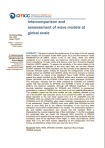This report analyses the performance of two state of the art spectral wave models: the European model WAM (cycle 4.6.2) and the American model WAWEWATCH III (WW3, version 5.16). In this study, WAM and WW3, configured to run at global scale, are treated as ‘stand-alone’ models and are forced considering 10-meter winds and sea-ice cover from Numerical Weather Prediction (NWP) systems. To assess the sensitivity of the wave models to the spatial and temporal resolution of the wind input data, we use two different ECMWF datasets: the ERA5 reanalysis and the analysis of the operational high- resolution forecast system. Initially we evaluate the configurations of the wave models (named as CGWAM and CGWW3, where CG is the acronym to indicate ‘CMCC Global’), by means of the Significant Wave Height (SWH) compared against the values provided by the CMEMS global wave analysis and forecast system (MFWAM) and the ECMWF ERA5 ocean wave reanalysis (ECWAM). This evaluation indicates that the SWH predicted by CGWAM and CGWW3 agrees with that provided by MFWAM and ECWAM in terms of large-scale patterns and seasonal variability, although with different magnitude. A more accurate statistical assessment for CGWAM and CGWW3 is successively conducted by means of CMEMS near real time in-situ and satellite observations. This validation shows that the wave models are both positively affected by the use of the ECMWF high resolution winds: if we consider the SWH, we observe a global reduction in the root mean square error of 4.7% (CGWAM) and 2% (CGWW3), when we validate the models against in-situ observations, and, 6.6% (CGWAM) and 2.4% (CGWW3), when Jason-3 altimetry measurements are used in the assessment. Overall, CGWW3 looks more skillful than CGWAM and this result is most likely due to the different formulation of the input and swell dissipation source terms implemented in the models. The assessment against in- situ and satellite observations also reveals that the modelled SWH is characterized by a global negative bias of few centimeters. To further investigate this systematic bias, we cluster the observed SWH according to different thresholds and it appears that the magnitude of the model bias increases with the increasing value of the significant wave height. In these circumstances (SWH larger than 2 m), the wave models, depending on the configuration and wind forcing, are affected by a bias which can vary from 20 to 70 cm.
CMCC InstitutesCMCC Divisions


